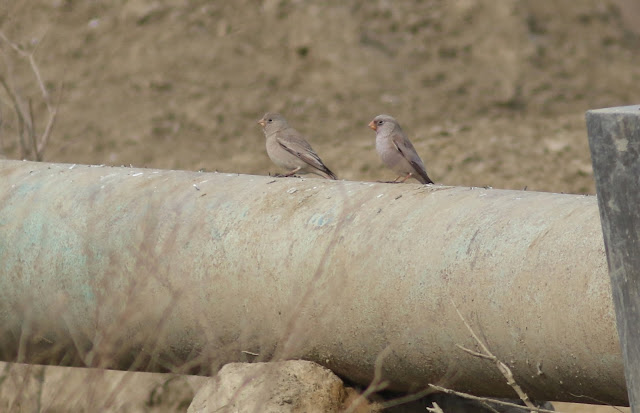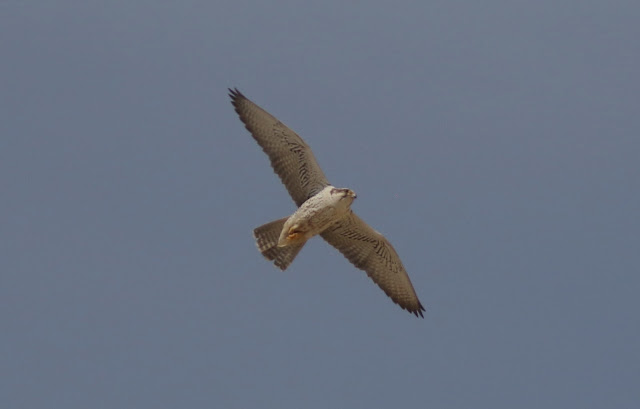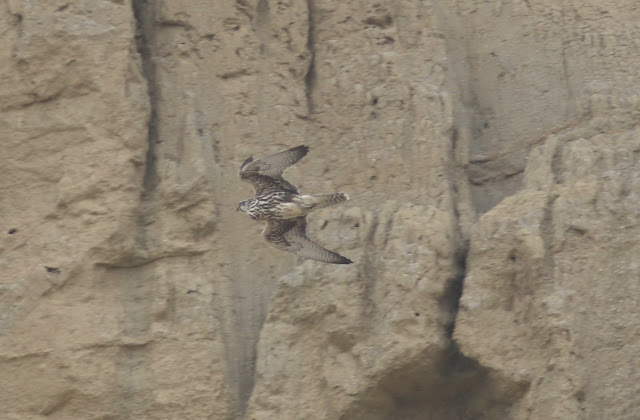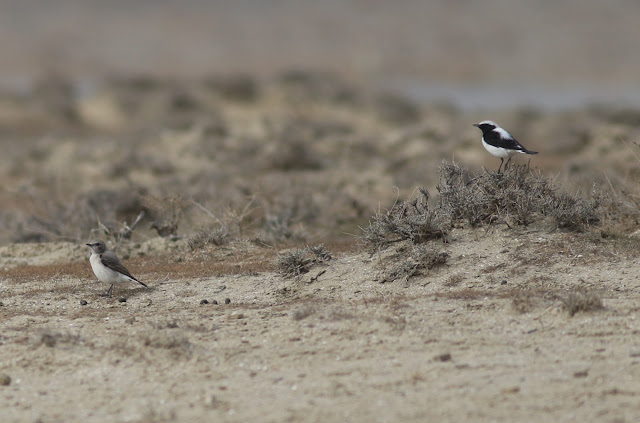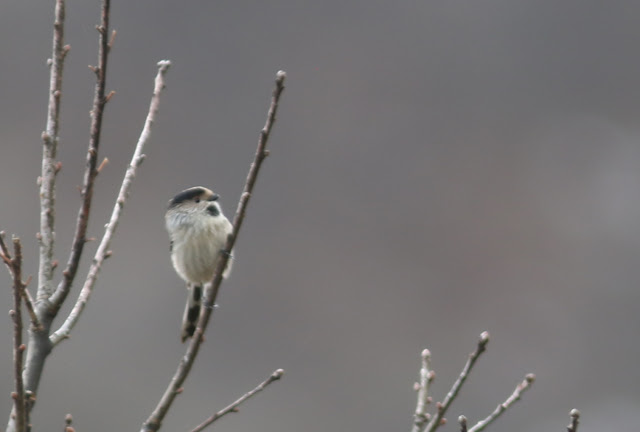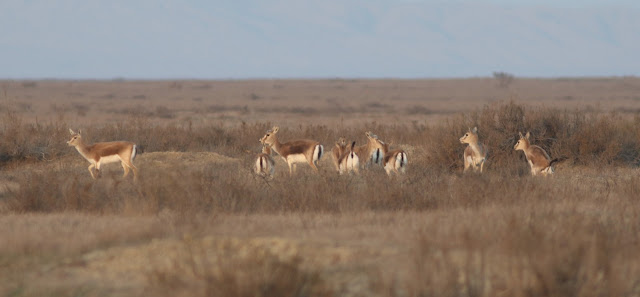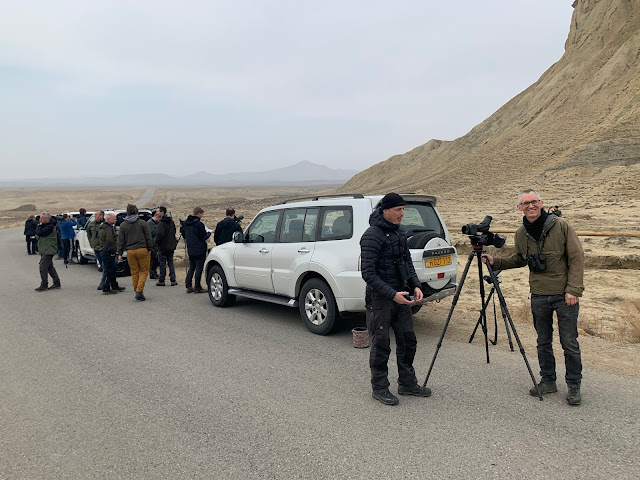Here's a few images of 'Ringed Plovers' from Terceira, the Azores, last week. There is a well known small (resident and migrant) population of Semipalmated Plover at Cabo da Praia quarry on Terceira, a site that also regularly hosts Ringed Plover, so it's a great place to practise separation/identification between the two species. We've had a least one case (on Corvo in 2016 see appendix) where a bird that had a loral stripe pattern like a Ringed Plover and was identified as such but later responded well to 'tape' and called repeatedly like a Semipalmated Plover and we also occasionally come across other less obvious birds too.
As a re-cap the features for Semipalmated Plover are 1) Loral stripe reaches above gape line 2) Yellowish eye-ring 3) Short and stumpy bill with an orange/red base 4) Semipalmations between front toes, conspicuous between middle and outer (Ringed can have semipalmations between inner and middle toe) 5) Small round head 6) Thin but unbroken breast band 7) Two-toned legs in first winter/juvenile 8) Unmarked and white underwing in flight and last but first in importance 9) 'Spotted Redshank-like' call.
Here's a sample of birds from last week of both species (if identified correctly- calls not heard on all birds and really need call to nail it home as we have seen puzzling birds in past where calls and field characteristics were not matches). A few less obvious birds below too . I had at least 4 of each Semipalmated and Ringed Plovers.
Semipalmated Plover
Loral line above gape line, semipalmations showing between middle and inner toe and thin unbroken breast band. Not much of an eye-ring visible in this image and legs not really two toned either. In this image not looking too round headed or stumpy-billed too. A good starting case of how many birds do not show the full suite of features. I'm working on if a bird has at least two or three features it's going in one box or the other but to be more towards certain need to confirm with call too.
Loral line above gapeline and hint of a yellow eye-ring. Stumpy billed and round headed. Quite a pale bird.
A nice short stumpy bill, round head, loral line above gape line, quite a prominent eye ring and also looks like that's a muddy semipalmation between the middle and outer toe. Looks like breast band is complete but need a better angle really. Same bird below.
Another relatively pale bird, loral line over gapeline and semipalmations shown between middle and inner toe. Not seeing this two toned legs on these birds. Again not particularly round headed in this image but bill is short and stumpy. Breast band thin and complete.
A bird in strong light probably accentuating the apparent relative darkness of the upperparts. Loral line where it should be, hint of eye ring and thin complete breast band.
A real classic- short stumpy bill, bright eye ring, rounded head, loral stripe above gape line, thin apparently unbroken breast band
Ringed Plover
A wide breast band, relatively thick loral stripe which seems to just about meet gape line. Zoom in to see but looks like no palmations even between middle and inner toe (which Ringed Plover can have sometimes)
A pale bird, a paleness which presumably contributes to the washed out loral stripe (which does seem to meet gape line). Same bird below. Quite stumpy billed but 'angular' head, relatively broad breast band at sides. Called several times as expected from Ringed Plover too.
Thick loral line which meets gape line. We have however had Semipalmated Plovers (or birds that called identical to Semipalmated Plovers with this loral line pattern in past though). The call is the really hammer home. Quite stumpy billed and a thin breast band. I think the image below is same bird.
Another image of a bird I'd like to hear call but with a loral line that meets the gapeline its going in the Ringed Plover box. No eye ring either but the breast band is narrow and structurally it quite stumpy billed and round headed. With resident Semipalmated Plovers in the quarry which could be breeding or even mix-pairing (no evidence I believe of anything along those lines) we perhaps don't need to summon the hybrid possibility but worth noting the haunting thought.

I'd say it's hammer time for something like this. Thick loral line that meets the gape line, quite a wide breast band, long necked and no hint of an eye ring. Quite a dark bird too. I generally assume the Ringed Plovers on the Azores are Tundra Ringed Plovers (Tundrae) as many look pretty dark (like this bird) on the upperparts. Also according to Duivendijk (2010) Tundra Ringed Plover moult into a more distinct winter plumage compared to Taiga Ringed Plover, hiaticula , which also seems to be the case here. Of note in Spring more fresh looking dark Ringed Plovers are more likely Tundra birds as they moult into a fresh spring plumage unlike Taiga birds.
Above and the others below- for all the reasons I keep repeating above I'm sticking these in the Ringed Plover box
Semipalmated or Ringed ?
Zoom on the face of this- not sure where that loral line and gape line meet and there seems to be an eye ring. The breast band is wide. Not sure what box to stick this one in. Again as always really need to hear the call on all of these birds. Same thing going on around the face of the bird below.
The loral line seems to meet the gape line but cant see eye ring or palmations between middle and outer toe and the breast band is quite wide at side too
This could be one the same birds above. Several 'Ringed Plovers' kept flying around the quarry so I was presumably coming across the same birds as I went round.
Hint of an eye ring and not sure what's going on with those lores. Wide sided breast band too. Bung it in the TDB (too difficult box).
Reference:
Advanced Bird ID Guide, The Western Palearctic. Nils Van Duivendijk, 2010.
Appendix
Semipalamated Plover on Corvo 2006 (Vincent Legrand). Called repeatedly like a Semipalmated Plover but lores not great (seem to meet just above gape line with a bit of imagination) and semipalmations not much to sing and dance about either. Eye ring present. Legs are two-toned. Most of us thought this was a Ringed Plover until it called.





